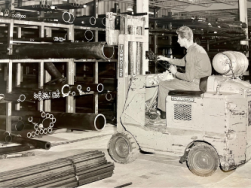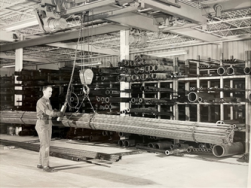State of Steel - December 2022
Pricing - Steel Index slowing but still falling
Steel pricing continues to be conflicting depending on what type and shape it is. Structural tubing prices have declined over the past month. Pricing is beginning to flatten out though due to the CRU index slowing. Structural tube pricing continues to be fluid and deals continue to be made in a competitive marketplace.
While structural tube pricing has declined, mechanical tube pricing remains elevated and lead times stretch out beyond 1st quarter of 2023. Most DOM and CDS prices seem to be hovering at their peak with no sign of decline coming. Contract pricing has seen several increases due to continued inflationary pressures and the necessity to assure the sustainability of the individual mills.
The CRU index came in at $618/ton this week. Last week it was $626/ton. Week-over-week change is -$8/ton. Looks like HRC continues to be on a slight downward trend with back-to-back week losses. That being said, US Steel, Cleveland-Cliffs, Stelco, and ArcelorMittal all announced a $60/ton price hike. It would appear that we are close to the bottom on coil pricing. The below charts reflect the CRU index and a current listing of all price increases/decreases on tubing that we have seen within the last year or so.



Cast Iron Pricing
November did not see any base increases for cast iron. Dura-Bar’s base price has remained constant since April 1st of 2022. Surcharges do appear to have topped out in May of 2022, as we have seen surcharges decrease 7 months in a row now. The below chart details the Dura-Bar surcharges over the last year or so.

Scrap & Steel Inputs
With the November scrap trade concluding with Midwest shredded scrap prices down $20/ton month-over-month (the 7th consecutive monthly decline) prices have now hit their lowest level since December 2020. Looking ahead, some market sources are indicating prices are approaching a bottom, with shrinking scrap inventories and reduced flows leading to a potential modest rebound. (Source: AMM)
The spread between hot-rolled coil and prime scrap prices has begun to narrow again after three months of stability. Prices for both products continue to move lower, as they have most weeks since May. The latest HRC-prime spread is one-fourth of what it was this time last year. The spread is also now at a 26-month low. (Source: SMU)
Metal Production
In the week ended November 26, US raw steel production decreased 0.2% week-over-week to 1,625,000 tons (-11.1% YoY). US capacity utilization was 72.8% vs 82.8% last year. This marks 20 consecutive weeks where capacity utilization has been below 80%. Weekly production and utilization are at their lowest levels since December 2020. Year-to-date production is 81,245,000 tons down 5.2% year-over-year from 85,705,000 tons last year. (Source: AISI)
US Steel confirmed that it will keep the #3 blast furnace at its Mon Valley Works idled until market dynamics improve. The furnace was originally taken offline in late August for a planned 30-day maintenance outage. (Source: SMU)
Global crude steel production was estimated at 147.3 million metric tons in October, down 2.9% sequentially, but up 1.1% year-over-year. (Source: SMU)
Lead Times
Understanding lead times for steel products are important to every participant in the supply chain. Lead times for steel products are as follows (as of 12/8/22):
Average HRC lead times increased last week to 4.6 weeks, which is below the average of 5.6 weeks since 2016. Other product lead times were mixed last week with CRC lead times at 5.9 weeks, HDG lead times at 6.8 weeks, and plate lead times at 5.1 weeks. (Source: Platts)
DOM, HRS, and CDS Tubing lead times continue to be long but have shortened slightly and are now anywhere from 20 to 36 weeks. The long lead times are due to backlog, supply issues, contract business, and labor shortages. We continue to see lead times be long and are now seeing availability not free up until mid-2023.
Structural Tubing mill lead times are shortened and running approximately 2-4 weeks upon receipt of order. Common sizes we can get sooner for now.
Dura-Bar Continuous Cast Iron mill lead times are approximately 4-6 weeks depending on size, grade, and finish. If it’s a large bar, special grade, size, or shape then the lead time could be considerably longer.
Imports/Exports
Based on the Commerce Department’s most recent Steel Import Monitoring and Analysis (SIMA) data, the American Iron and Steel Institute (AISI) reported today that steel import permit applications for the month of November totaled 2,113,000 net tons (NT)*. This was a 9.6% decrease from the 2,336,000 permit tons recorded in October and a 12.6% decrease from the October final imports total of 2,416,000. Import permit tonnage for finished steel in November was 1,891,000, down 3.9% from the final imports total of 1,968,000 in October. For the first eleven months of 2022 (including November SIMA permits and October final imports), total and finished steel imports were 28,747,000 NT and 23,527,000 NT, up 0.6% and 14.7%, respectively, from the same period in 2021. The estimated finished steel import market share in November was 23% and is 24% year-to-date (YTD). (Source: AISI)
Economic Factors
Congress passed a bill that would force a tentative rail labor agreement and thwart a national strike. (Source: CNBC)
New orders for US-manufactured durable goods rose sequentially in October by 1.0% (ahead of estimates of 0.4%) to a seasonally adjusted $277.4 billion. That figure has risen for seven out of the last eight months. However, excluding transportation, new orders decreased by 0.5%. (Source: SMU)
Existing home sales declined by 5.9% in October month-over-month and declined by 28.4% year-over-year. This marks the 9th consecutive monthly decline and is the slowest sales pace since December 2011 (except for a very brief drop at the beginning of the pandemic). Even as sales slow, supply remains low. There were 1.22 million homes for sale at the end of October, a decrease of 0.8% month-over-month and year-over-year. That’s a 3.3-month supply at the current sales pace. Historically, a balanced market is considered to be a 6-month supply. (Source: CNBC)
Oil & Gas Industry
The US rig count increased 0.3% week-over-week to 784 rigs as of 11/25. The rig count is up 37.8% year-over-year. (Source: Baker Hughes)
OPEC and its allies are increasingly expected to hold production steady after the group shifted its meeting online amid an uncertain market outlook. (Source: Yahoo)
Employment/Hiring
Approximately 0.225 million Americans filed for unemployment insurance last week. This was better than economists’ expectations of 0.235 million claims and better than last week’s upwardly revised claims number of approximately 0.241 million claims. However, continuing claims increased during the week ending November 19 (continuing claims have a week lag in terms of reporting), and stand at approximately 1.61 million continuing claims, which is the highest level since March. (Source: Yahoo)






